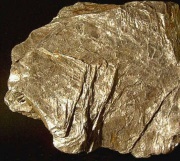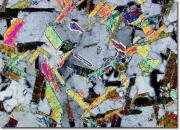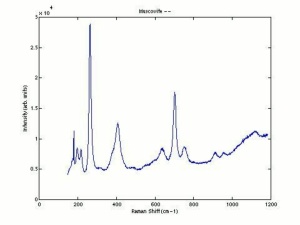Difference between revisions of "Muscovite"
(username removed) |
|||
| (4 intermediate revisions by 2 users not shown) | |||
| Line 1: | Line 1: | ||
[[File:Muskovit-Pilsak.jpg|thumb|Muscovite]] | [[File:Muskovit-Pilsak.jpg|thumb|Muscovite]] | ||
== Description == | == Description == | ||
| + | [[File:muscovitelarge.jpg|thumb|Muscovite]] | ||
| + | A light colored mica mineral composed of potassium aluminum silicate hydroxide fluoride. Muscovite is the most common type of [[mica|mica]]. The transparent to translucent mineral can be colorless, pale yellow, green, gray, or light brown. It cleaves easily to form thin, flexible mineral sheets. The name [[Muscovy%20glass|Muscovy glass]] was formerly used for this mineral because of its use by Russians for windows. Significant muscovite deposits occur in India (Nellore), Pakistan, Brazil and the U.S. (New England, Pennsylvania, Maryland, Virginia, North Carolina, Georgia, South Dakota, New Mexico). A rare variety found in Brazil has twinned crystals that form yellow five-pointed stars (star muscovite). Muscovite is a good electrical and thermal insulator. For many years, it was used for kitchen oven windows. Muscovite is still used as an electrical insulator and as a fireproofing material. | ||
| − | + | [[[SliderGallery rightalign|Muscovite mica (very thin).TIF~FTIR (MFA)|Muscoviteitaly2.jpg~Raman]]] | |
| − | |||
| − | |||
== Synonyms and Related Terms == | == Synonyms and Related Terms == | ||
white mica; potash mica; potash silicate; potassium mica; common mica; isinglass; Muscovy glass; star muscovite; Muscovit (Deut.); Moskauer Glas (Deut.); muscovita (Esp.); muscovite (Fr., Port.); muscoviet (Ned.); muscowit (Pol.) | white mica; potash mica; potash silicate; potassium mica; common mica; isinglass; Muscovy glass; star muscovite; Muscovit (Deut.); Moskauer Glas (Deut.); muscovita (Esp.); muscovite (Fr., Port.); muscoviet (Ned.); muscowit (Pol.) | ||
| − | + | ==Physical and Chemical Properties== | |
| − | + | * Monoclinic crystal system with pseudo-hexagonal forms. | |
| − | + | * High birefringence. | |
| − | Monoclinic crystal system with pseudo-hexagonal forms. High birefringence. | + | * Cleavage = laminar forming thin, elastic plates. |
| − | + | * Luster = vitreous to pearly. | |
| − | Cleavage = laminar forming thin, elastic plates. | + | * Streak = colorless. |
| − | + | * Fracture = uneven. | |
| − | Luster = vitreous to pearly. Streak = colorless. Fracture = uneven. | ||
{| class="wikitable" | {| class="wikitable" | ||
| Line 28: | Line 27: | ||
|- | |- | ||
! scope="row"| Density | ! scope="row"| Density | ||
| − | | 2.7-3.0 | + | | 2.7-3.0 g/ml |
|- | |- | ||
! scope="row"| Refractive Index | ! scope="row"| Refractive Index | ||
| Line 34: | Line 33: | ||
|} | |} | ||
| − | == | + | ==Resources and Citations== |
| − | |||
| − | |||
| − | + | * Mineralogy Database: [http://www.webmineral.com/data/Muscovite.shtml Muscovite] | |
* R. J. Gettens, G.L. Stout, ''Painting Materials, A Short Encyclopaedia'', Dover Publications, New York, 1966 Comment: density=2.89; ref. index=1.563; 1.604; 1.599 | * R. J. Gettens, G.L. Stout, ''Painting Materials, A Short Encyclopaedia'', Dover Publications, New York, 1966 Comment: density=2.89; ref. index=1.563; 1.604; 1.599 | ||
| Line 46: | Line 43: | ||
* Frank A. Lent, ''Trade names and Descriptions of Marbles, Limestones, Sandstones, Granites and Other Building Stones Quarried in the United States Canada and other Countries.'', Stone Publishing Co, New York, 1925 | * Frank A. Lent, ''Trade names and Descriptions of Marbles, Limestones, Sandstones, Granites and Other Building Stones Quarried in the United States Canada and other Countries.'', Stone Publishing Co, New York, 1925 | ||
| − | * ''Encyclopedia Britannica'', http://www.britannica.com Comment: "muscovite" | + | * ''Encyclopedia Britannica'', http://www.britannica.com Comment: "muscovite" [Accessed December 4, 2001]. |
* C.W.Chesterman, K.E.Lowe, ''Audubon Society Field Guide to North American Rocks and Minerals'', Alfred A. Knopf, New York, 1979 | * C.W.Chesterman, K.E.Lowe, ''Audubon Society Field Guide to North American Rocks and Minerals'', Alfred A. Knopf, New York, 1979 | ||
| − | * Wikipedia | + | * Wikipedia: http://en.wikipedia.org/wiki/Muscovite (Accessed Sept. 10, 2005) |
* G.S.Brady, ''Materials Handbook'', McGraw-Hill Book Co., New York, 1971 Comment: p. 505 | * G.S.Brady, ''Materials Handbook'', McGraw-Hill Book Co., New York, 1971 Comment: p. 505 | ||
Latest revision as of 18:44, 3 August 2022
Description
A light colored mica mineral composed of potassium aluminum silicate hydroxide fluoride. Muscovite is the most common type of Mica. The transparent to translucent mineral can be colorless, pale yellow, green, gray, or light brown. It cleaves easily to form thin, flexible mineral sheets. The name Muscovy glass was formerly used for this mineral because of its use by Russians for windows. Significant muscovite deposits occur in India (Nellore), Pakistan, Brazil and the U.S. (New England, Pennsylvania, Maryland, Virginia, North Carolina, Georgia, South Dakota, New Mexico). A rare variety found in Brazil has twinned crystals that form yellow five-pointed stars (star muscovite). Muscovite is a good electrical and thermal insulator. For many years, it was used for kitchen oven windows. Muscovite is still used as an electrical insulator and as a fireproofing material.
Synonyms and Related Terms
white mica; potash mica; potash silicate; potassium mica; common mica; isinglass; Muscovy glass; star muscovite; Muscovit (Deut.); Moskauer Glas (Deut.); muscovita (Esp.); muscovite (Fr., Port.); muscoviet (Ned.); muscowit (Pol.)
Physical and Chemical Properties
- Monoclinic crystal system with pseudo-hexagonal forms.
- High birefringence.
- Cleavage = laminar forming thin, elastic plates.
- Luster = vitreous to pearly.
- Streak = colorless.
- Fracture = uneven.
| Composition | KAl2(AlSi3O10)(F,OH)2 |
|---|---|
| Mohs Hardness | 2.0 - 2.5 |
| Density | 2.7-3.0 g/ml |
| Refractive Index | 1.563; 1.604; 1.599 |
Resources and Citations
- Mineralogy Database: Muscovite
- R. J. Gettens, G.L. Stout, Painting Materials, A Short Encyclopaedia, Dover Publications, New York, 1966 Comment: density=2.89; ref. index=1.563; 1.604; 1.599
- Robert Fournier, Illustrated Dictionary of Practical Pottery, Chilton Book Company, Radnor, PA, 1992
- Frank A. Lent, Trade names and Descriptions of Marbles, Limestones, Sandstones, Granites and Other Building Stones Quarried in the United States Canada and other Countries., Stone Publishing Co, New York, 1925
- Encyclopedia Britannica, http://www.britannica.com Comment: "muscovite" [Accessed December 4, 2001].
- C.W.Chesterman, K.E.Lowe, Audubon Society Field Guide to North American Rocks and Minerals, Alfred A. Knopf, New York, 1979
- Wikipedia: http://en.wikipedia.org/wiki/Muscovite (Accessed Sept. 10, 2005)
- G.S.Brady, Materials Handbook, McGraw-Hill Book Co., New York, 1971 Comment: p. 505
- Richard S. Lewis, Hawley's Condensed Chemical Dictionary, Van Nostrand Reinhold, New York, 10th ed., 1993
- Van Nostrand's Scientific Encyclopedia, Douglas M. Considine (ed.), Van Nostrand Reinhold, New York, 1976
- Random House, Webster's Encyclopedic Unabridged Dictionary of the English Language, Grammercy Book, New York, 1997
- The American Heritage Dictionary or Encarta, via Microsoft Bookshelf 98, Microsoft Corp., 1998
- CRC Handbook of Chemistry and Physics, Robert Weast (ed.), CRC Press, Boca Raton, Florida, v. 61, 1980 Comment: density=2.76-3.00



